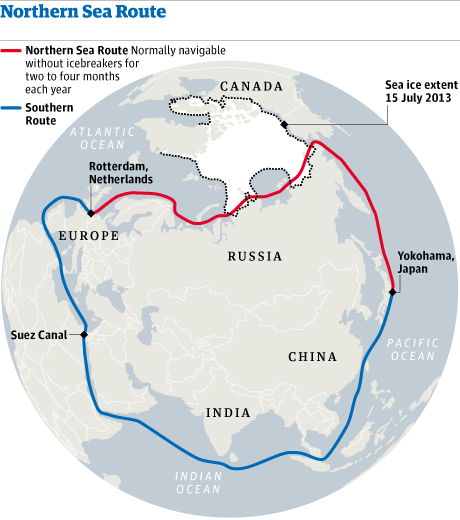What is the issue?
- A cargo vessel had recently passed through the Russian Arctic on a trial journey as a result of melting sea ice.
- This is more an indication of emergence of new shipping routes as global warming continues.
What was the trial?
- A P Moller-Maersk is the world’s biggest shipping group.
- It had one of its cargo vessels pass through the Russian Arctic on a trial journey.
- The ship arrived in St Petersburg on the Gulf of Finland after leaving Vladivostok on the North Pacific.
How is the Arctic changing?
- Climate change is resulting in parts of the Arctic warming up to 100% faster than elsewhere.
- The extent of sea ice covering the Arctic Ocean has declined in every decade since the 1980s.
- There is evidence that ancient, thick ice is disappearing as well.
- The average Arctic sea ice volume was 3,302 cubic miles (or more than 13,750 cubic km) between 1985 and 2000.
- This is expected to fall to an average of 1,480 cubic miles between 2015 and 2030 under a moderate emissions scenario.
- It could well come down to just 737 cubic miles (3,000 cubic km) on average between 2045 and 2060.

What is the emerging scenario?
- The world is likely on the cusp of a shipping revolution as a consequence of climate change.
- “Middle of the road” warming is a warming phenomenon higher than the 2015 Paris Climate Accord target but lower than the most extreme forecasts of climate change.
- Resultantly, as sea ice reduce decade on decade, it will open up vast swathes of the Arctic Ocean.
- The ships may, by the middle of this century, be able to pass directly over the North Pole.
- The route from the north of Russia to the north of Canada can be taken at least for some weeks in the summer-fall.
- The Northern Sea Route could potentially cut the travel distance between East Asia and Western Europe.
- It could bring down the distance from 21,000 km to just 12,800 km, and the journey time by 10-15 days.
- The current route is via the Malacca Strait, Indian Ocean, Gulf of Aden and Suez Canal.
- As voyage times fall significantly, shipping could become more attractive in north than the southern routes.
- Shipping activity in the region is thus likely to increase significantly over the next decade.
- It is also aided by the fact that Russia is likely to develop oil and gas fields in Siberia.
What is the challenge?
- Costs will be a major consideration towards the above transformation.
- Reportedly, Trans-Arctic shipping by ordinary vessels between Europe and Asia is unlikely to become economically viable before 2040.
- So the Northern Sea Route is currently not a viable commercial alternative to existing east-west routes.
- Also, Arctic ice conditions will still vary greatly from year to year.
- The passage is only feasible for around three months a year.
- This could discourage shippers for whom keeping to schedules is important.
- Increased insurance costs and safety considerations are other deterrents.
Source: Indian Express
